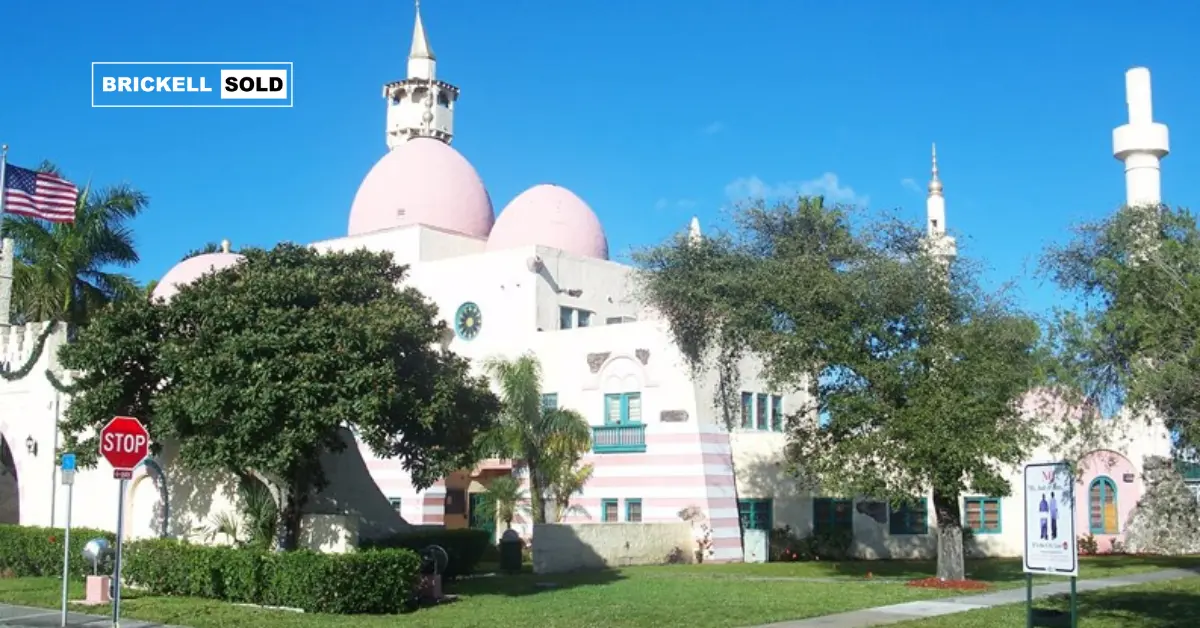Nestled in northwestern Miami-Dade County, Florida, the city of Opa-locka is a gem of architectural and cultural uniqueness. Conceived with an Arabian Nights theme, Opa-locka stands apart as a rare and fascinating example of themed urban planning in the United States. Its story is one of vision, creativity, resilience, and transformation—a city that remains a testament to its founder’s dreams while embracing its evolving role in the modern era.
The Visionary Behind Opa-locka
Opa-locka was founded in 1926 by Glenn Hammond Curtiss, a legendary aviation pioneer known for his contributions to early flight. Curtiss, who also played a significant role in developing other South Florida cities such as Hialeah and Miami Springs, envisioned Opa-locka as a fantastical Arabian-themed city inspired by the tales of One Thousand and One Nights.
Curtiss partnered with architect Bernhardt E. Muller to design the city, imbuing it with Moorish Revival architecture. The design incorporated domes, minarets, arches, and intricate arabesque motifs, creating a skyline unlike any other in the United States. Curtiss’s vision extended beyond architecture to the very streets themselves, which were given names like Ali Baba Avenue, Sharazad Boulevard, Sultan Avenue, and Aladdin Street.
The name “Opa-locka” is derived from the Native American term “Opa-tisha-wocka-locka,” which translates to “a big island covered with many trees and swamps.” This nod to the area’s indigenous roots contrasts with the Arabian fantasy theme that dominates the city’s aesthetic.
Discover the fascinating architecture and history of Opa-locka real estate, a hidden gem in Miami-Dade County.
Architectural Wonders
At its peak, Opa-locka featured over 100 Moorish Revival buildings, making it the largest such collection in the Western Hemisphere. While many of these structures have been lost to time and urban development, several remain and are protected as part of the Opa-locka Thematic Resource Area, which is listed on the National Register of Historic Places.
Key Landmarks
- Opa-locka Company Administration Building (The People’s Palace)
This building, often called “The Nation’s Weirdest City Hall,” is the crown jewel of Opa-locka’s architecture. Adorned with domes, arches, and decorative tilework, it served as the administrative hub for the city and a centerpiece of Curtiss’s vision. Currently undergoing restoration, it remains a symbol of Opa-locka’s unique heritage. - Opa-locka Railroad Station
Designed to resemble a mosque, this station was integral to the city’s transportation network and a key part of its identity. Built in 1927, the station showcases the Moorish architectural elements that define the city. - Harry Hurt Building
This building, originally constructed as the city’s first apartment house and store structure, reflects the distinctive Moorish Revival style. It is one of the best-preserved examples of Opa-locka’s early architecture. - Crouse House
Designed by Bernhardt E. Muller in 1926, this private residence features signature elements of the Moorish style, including arched windows and decorative detailing. - Opa-locka Bank Building
Originally intended as a bank, this building later became a church. Its design merges Moorish and Egyptian Revival styles, making it a unique part of Opa-locka’s architectural portfolio.
Preservation Efforts
In recent years, efforts have been made to restore and preserve Opa-locka’s historic buildings. Organizations like the Opa-locka Community Development Corporation (OLCDC) have worked to secure funding and raise awareness about the city’s architectural significance. These efforts aim to protect the remaining structures and revitalize the city as a cultural and historical destination.
Explore investment opportunities in Opa-locka FL homes, surrounded by rich culture and iconic landmarks.
The City’s Layout and Thematic Consistency
Opa-locka’s urban design reflects Curtiss’s commitment to creating an immersive experience. Streets with names like Sesame, Sabur, and Ali Baba reinforce the Arabian theme, while public spaces like parks and plazas were designed to complement the overall aesthetic.
The city occupies 4.2 square miles and is divided into residential, commercial, and industrial zones. Despite its thematic origins, Opa-locka has evolved into a modern urban community with diverse land use and a vibrant population.
Find luxurious Miami real estate listings on Brickell Sold, connecting you to upscale properties tailored for your lifestyle.
Aviation Heritage
Glenn Curtiss’s background as an aviation pioneer is deeply embedded in Opa-locka’s history. The Miami-Opa locka Executive Airport, established on land originally owned by Curtiss, is Miami’s oldest airport. During World War II, it served as a Naval Air Station, playing a crucial role in training pilots and supporting the war effort.
Today, the airport continues to function as a hub for general aviation, with a focus on private and corporate aircraft. It is one of the city’s most significant assets, contributing to its economic development and maintaining its historical connection to aviation.
Explore exceptional Florida preconstruction homes with Preconstruction Info, featuring developments in sought-after neighborhoods.
Cultural and Social Significance
Opa-locka’s Arabian Nights theme extends beyond architecture to cultural identity. The city has hosted events and festivals celebrating its unique heritage, including the Arabian Nights Fantasy Festival, which features performances, art, and culinary experiences inspired by Middle Eastern culture.
Despite its rich cultural history, Opa-locka has faced significant challenges. Economic downturns, corruption scandals, and crime have impacted the city’s reputation and quality of life. However, the community has demonstrated resilience, with ongoing efforts to address these issues and promote economic development.
Revitalization and Modern-Day Opa-locka
In recent years, Opa-locka has embarked on a journey of revitalization. The OLCDC and other organizations have spearheaded projects to restore historic buildings, improve infrastructure, and attract investment. These initiatives aim to preserve the city’s heritage while fostering growth and opportunity for its residents.
Community Initiatives
- Affordable Housing Projects
The OLCDC has developed affordable housing units to address the needs of low-income residents, helping to stabilize neighborhoods and improve living conditions. - Public Art and Cultural Programs
Public art installations and cultural programs have been introduced to celebrate Opa-locka’s heritage and engage the community. These initiatives have brought vibrancy and creativity to public spaces. - Economic Development
Efforts to attract businesses and create jobs have focused on leveraging Opa-locka’s unique identity and strategic location. The city’s proximity to major transportation hubs makes it an attractive destination for industries such as logistics and manufacturing.
Learn why Opa-locka FL properties are attracting attention for their unique Arabian-themed charm.
Visiting Opa-locka
For visitors interested in history, architecture, and culture, Opa-locka offers a unique experience. Guided tours of the city’s historic landmarks provide insight into its origins and evolution. The city’s parks and lakes offer recreational opportunities, while local events and festivals showcase its vibrant community spirit.
Suggested Itinerary
- Morning: Start your day with a visit to the Opa-locka City Hall (The People’s Palace) and the Harry Hurt Building.
- Afternoon: Explore the Opa-locka Railroad Station and enjoy a picnic at Sherbondy Park.
- Evening: Attend a local cultural event or dine at a nearby restaurant to experience the city’s diverse culinary scene.
Conclusion
Opa-locka is more than just a city; it is a living work of art, a bold experiment in themed urban planning, and a community with a rich and complex history. Its unique blend of architectural grandeur, cultural significance, and resilience makes it a fascinating destination for residents and visitors alike. As efforts to restore and revitalize Opa-locka continue, the city stands as a testament to the power of imagination and the enduring spirit of its people.

